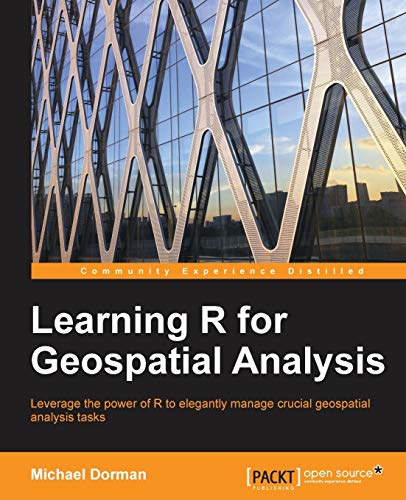-
Stone Soup
Carl Sommer, Michael Denman
language (Advance Publishing, Nov. 12, 2013)When three hungry soldiers enter the village, the selfish villagers hide rather than welcome them. To teach the villagers that sharing brings joy, they announce they are making soup from stones. This idea is so surprising that the soldiers convince the self-centered villagers to add something to their soup for additional flavor. Their contributions to the water and stones become a delicious pot of soup. Soup-making turns into a village-wide celebration and changes the villagers forever. This retelling of the classic folktale demonstrates community spirit and the joy of sharing.
-
Learning R for Geospatial Analysis
Michael Dorman
eBook (Packt Publishing, Dec. 26, 2014)Leverage the power of R to elegantly manage crucial geospatial analysis tasksAbout This BookWrite powerful R scripts to manipulate your spatial dataGain insight from spatial patterns utilizing R's advanced computation and visualization capabilitiesWork within a single spatial analysis environment from start to finishWho This Book Is ForThis book is intended for anyone who wants to learn how to efficiently analyze geospatial data with R, including GIS analysts, researchers, educators, and students who work with spatial data and who are interested in expanding their capabilities through programming. The book assumes familiarity with the basic geographic information concepts (such as spatial coordinates), but no prior experience with R and/or programming is required. By focusing on R exclusively, you will not need to depend on any external software—a working installation of R is all that is necessary to begin.What You Will LearnMake inferences from tables by joining, reshaping, and aggregatingFamiliarize yourself with the R geospatial data analysis ecosystemPrepare reproducible, publication-quality plots and mapsEfficiently process numeric data, characters, and datesReshape tabular data into the necessary form for the specific task at handWrite R scripts to automate the handling of raster and vector spatial layersProcess elevation rasters and time series visualizations of satellite imagesPerform GIS operations such as overlays and spatial queries between layersSpatially interpolate meteorological data to produce climate mapsIn DetailR is a simple, effective, and comprehensive programming language and environment that is gaining ever-increasing popularity among data analysts.This book provides you with the necessary skills to successfully carry out complete geospatial data analyses, from data import to presentation of results.Learning R for Geospatial Analysis is composed of step-by-step tutorials, starting with the language basics before proceeding to cover the main GIS operations and data types. Visualization of spatial data is vital either during the various analysis steps and/or as the final product, and this book shows you how to get the most out of R's visualization capabilities. The book culminates with examples of cutting-edge applications utilizing R's strengths as a statistical and graphical tool.
-
Evolution: Still a Theory in Crisis
Michael Denton
Paperback (Discovery Institute, Jan. 6, 2016)More than thirty years after his landmark book Evolution: A Theory in Crisis (1985), biologist Michael Denton revisits his earlier thesis about the inability of Darwinian evolution to explain the history of life. He argues that there remains “an irresistible consilience of evidence for rejecting Darwinian cumulative selection as the major driving force of evolution.” From the origin of life to the origin of human language, the great divisions in the natural order are still as profound as ever, and they are still unsupported by the series of adaptive transitional forms predicted by Darwin. In addition, Denton makes a provocative new argument about the pervasiveness of nonadaptive order throughout biology, order that cannot be explained by the Darwinian mechanism.
-
Real Talk for Boys "A Survival Guide": 101 Secrets Every Young Man Needs to Know
michael dennis
language (, April 2, 2018)"Real Talk" for boys is truly a must read for every young man growing in this contemporary society. The lessons taught in this book can/will literally save their lives. These lessons are straight from the mouths and lives of those who have not only "talked the talk, but have walked the walk" as well. From the streets of Chicago to the streets of Compton, these rules don't change. Not knowing the rules isn't an option. :Game recognize game.: Don't get caught slippin'. Read "Real Talk". And get "the real."
-
The Miller, His Son, and their Donkey
Carl Sommer, Michael Denman
language (Advance Publishing, Nov. 11, 2013)The miller Elmo and his son Mort have a problem—instead of standing up for what they know is right, they follow everyone else’s opinions. When a farmer complains that Elmo is overworking the donkey, Elmo and Mort mill the grain. When others complain that his prices are too high, Elmo reduces the price, even if he’s losing money. When a friend suggests Mort steal apples with him, Mort goes along with the plan.Their trouble worsens when they take their donkey to sell at the market and listen to all the advice they hear along the way. By trying to please everyone, they end up pleasing no one and losing their donkey. This retelling of Aesop’s classic fable illustrates that the path to success means standing up for what is right.
-
Secrets Every Christian Need to Know Now: Exposing the Devil's Play Book
Michael Dennis
eBookThe "Enemy" is real. And he's here. Learn the tricks he uses to kill, steal and destroy "believers". Satan is no joke. Don't take him for granted. This books brings his schemes to light. Only the "Light" can defeat darkness. Read this book and defeat the "schemes" of the "evil one". The book is bible based and reality based.
-
The King and Queen of Moonlight Bay
Michael de Guzman
eBook (, Aug. 12, 2015)At fifteen, Alison decides it's time to get to know her father, who abandoned her when she was a child. She wants to spend the summer with him. He writes back, telling her she won't like it. He attempts to dissuade her. He fails. Their summer is a struggle. She brings her anger, seeking answers. He tries to drive her away. The novel is about their fight to find a relationship, and the distance they travel over a summer. It is intended for kids twelve to fifteen.
-
Learning R for Geospatial Analysis
Michael Dorman
Paperback (Packt Publishing, Dec. 26, 2014)Leverage the power of R to elegantly manage crucial geospatial analysis tasksAbout This BookWrite powerful R scripts to manipulate your spatial dataGain insight from spatial patterns utilizing R's advanced computation and visualization capabilitiesWork within a single spatial analysis environment from start to finishWho This Book Is ForThis book is intended for anyone who wants to learn how to efficiently analyze geospatial data with R, including GIS analysts, researchers, educators, and students who work with spatial data and who are interested in expanding their capabilities through programming. The book assumes familiarity with the basic geographic information concepts (such as spatial coordinates), but no prior experience with R and/or programming is required. By focusing on R exclusively, you will not need to depend on any external software—a working installation of R is all that is necessary to begin.What You Will Learn Make inferences from tables by joining, reshaping, and aggregating Familiarize yourself with the R geospatial data analysis ecosystem Prepare reproducible, publication-quality plots and maps Efficiently process numeric data, characters, and dates Reshape tabular data into the necessary form for the specific task at hand Write R scripts to automate the handling of raster and vector spatial layers Process elevation rasters and time series visualizations of satellite images Perform GIS operations such as overlays and spatial queries between layers Spatially interpolate meteorological data to produce climate maps In DetailR is a simple, effective, and comprehensive programming language and environment that is gaining ever-increasing popularity among data analysts.This book provides you with the necessary skills to successfully carry out complete geospatial data analyses, from data import to presentation of results.Learning R for Geospatial Analysis is composed of step-by-step tutorials, starting with the language basics before proceeding to cover the main GIS operations and data types. Visualization of spatial data is vital either during the various analysis steps and/or as the final product, and this book shows you how to get the most out of R's visualization capabilities. The book culminates with examples of cutting-edge applications utilizing R's strengths as a statistical and graphical tool.
-
Level 2: Extreme Sports
Michael Dean
eBook (Pearson Education, Sept. 7, 2015)Original / American EnglishUp in the air! Down on the ground! Under the water! Extreme sports are new, exciting, and dangerous! Learn about extreme sports from aerial ballet to zorbing. Read about the crazy people who love extreme sports. Are extreme sports for you?
-
A Ghost in Love and Other Plays Level 1 Oxford Bookworms Library
Michael Dean
eBook (Oxford University Press, Feb. 10, 2012)A level 1 Oxford Bookworms Library graded reader. Written for Learners of English by Michael Dean.Do you believe in ghosts? Jerry doesn't. He's a nineteen-year-old American, who just wants a good holiday with his friend, Brad. They are travelling round the north of England by bicycle. But strange things begin to happen in the small hotel where they are staying. First, Brad seems to think that he has been there before. And then a girl called Ellen appears . . . The first of these three original plays is set in the seventeenth century, and the other two take place in modern times. In each play, a ghost comes back from the dead to change the lives of living people.
-
A Ghost in Love and Other Plays - With Audio Level 1 Oxford Bookworms Library
Michael Dean
eBook (Oxford University Press, March 5, 2015)A level 1 Oxford Bookworms Library graded reader. This version includes an audio book: listen to the story as you read.Written for Learners of English by Michael Dean.Do you believe in ghosts? Jerry doesn't. He's a nineteen-year-old American, who just wants a good holiday with his friend, Brad. They are travelling round the north of England by bicycle. But strange things begin to happen in the small hotel where they are staying. First, Brad seems to think that he has been there before. And then a girl called Ellen appears . . . The first of these three original plays is set in the seventeenth century, and the other two take place in modern times. In each play, a ghost comes back from the dead to change the lives of living people.
-
Daniel Webster, Defender of the Union
Bob Allen, Michael L Denman
Paperback (Mott Media, May 1, 1989)The farm boy who became lawyer, congressman, senator, and Secretary of State. Q
Q